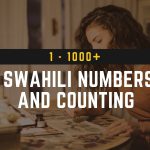Did you experience traveling without money? Of course, it’s hard to enjoy a place if you are on a tight budget. Today, we will learn about the Korean currency or 통화 (tong hwa), and discover related words. If you are ready for that, then let the learning begin!
South Korea is indeed one of the most in-demand countries to visit. Well, it makes sense because who wouldn’t fall in love with a country that is rich in culture? They have Korean food, K-pop, K-dramas, and more. But, we cannot deny the fact that traveling, not just in South Korea, will cost you money.
If you want to go to South Korea and splurge on good finds, you should familiarize yourself with the South Korean currency, or 대한민국원 (daehanminguk won). So today, we will talk about Korean money, which is the Korean won, the official and only legal currency of the Korean Republic. Remember that we will only talk about the currency of South Korea. We will not include North Korea, which has an entirely different concept for this topic. So, don’t worry because this lesson is totally easy to remember.
Talking About Money In Korean
In learning about Korean currency, we should also learn how to talk about Korean money. If you can still recall our lesson about Korean numbers, there are two numerical systems. The first is the Sino-Korean system which is based on Chinese characters. Sino-Korean is used for money, dates, phone numbers, minutes, seconds, and addresses. On the other hand, the Native Korean system is used for ages, counting, and hours.
It is essential to know this because we cannot talk about currency without using numbers in Korean. So, let’s have a quick review.
| English Translation | Hangeul (Korean) | Romanization |
| one | 일 | il |
| two | 이 | i |
| three | 삼 | sam |
| four | 사 | sa |
| five | 오 | o |
| six | 육 | yuk |
| seven | 칠 | chil |
| eight | 팔 | pal |
| nine | 구 | gu |
| ten | 십 | sip |
| hundred | 백 | baek |
| thousand | 천 | cheon |
| ten thousand | 만 | man |
| a hundred thousand | 십만 | sip-man |
| a million | 백만 | baek-man |
| ten million | 천만 | cheon-man |
| a hundred million | 일억 | il-eok |
| a billion | 십억 | sip-eok |
Now that you have learned the Sino-Korean numbers used for money, take a look at the example below:
Formula: Sino Korean Number + 천 + 원
| Amount | Hangeul (Korean) | Romanization |
| ₩ 1,000 | 천 원 | cheon won |
| ₩ 2,000 | 이천 원 | icheon won |
| ₩ 3,000 | 삼천 원 | samcheon won |
Remember, when you want to talk about ₩ 1,000, you can just say 천 원 (cheon won) instead of 일천 원 (ilcheon won).
The second way to talk about money in Korean is:
Formula: Sino Korean Number + 만 + 원
| Amount | Hangeul (Korean) | Romanization |
| ₩ 10,000 | 만 원 | man won |
| ₩ 20,000 | 이만 원 | iman won |
| ₩ 30,000 | 삼만 원 | samman won |
Take note that if you want to say ₩ 10,000, you can make use of 만 원 (man won) instead of 일만 원 (ilman won).
Learning About South Korean Won
원 – Won
Let’s start with the official currency of South Korea, which is 원 (won). The symbol that represents the Korean won is ₩. For the currency code, KRW is used to refer to the Korean won. In South Korea, a single won is divided into 100 jeon, the monetary subunit. But, take note that South Koreans no longer use this for everyday transactions. It is only used for the foreign exchange rates. In this country, the Bank of Korea, which is located in Seoul, issues the currency.
Just a short throwback, did you know that Korean won, Japanese Yen, and Chinese Yuan were all derived from the Spanish-American silver dollar? From the 16th to the 19th century, this coin was widely used for international trade between Asia and the Americas.
Fast forward to 1910-45, which is the Japanese invasion, the won was replaced by the Korean yen and is at par with the Japanese yen.
When World War II ended in 1945, Korea was divided into North and South Korea. This gave way for Korea to have two separate currencies, but these currencies are both called won – Northern won and Southern won. The Northern won replaced the yen, and the first South Korean won was divided into 100 jeon.
Moving forward to 1946, the Bank of Joseon issued the first South Korean Won bills, which the Bank of Korea later replaced. The Bank of Korea, which is the new central bank, took over the functions of the Bank of Joseon and was created in 1950.
South Korean Currency: Korean Bills (한국 지폐 Hanguk jipye)
In South Korea, you wouldn’t have a hard time because there are only four Korean bills that the Bank of Korea issues. They are 1,000 won, 5,000 won, 10,00 won, and 50,000 won. Fun fact, Korean bills increase their size as their value goes up. So, below are the Korean bills and a short trivia about the things and people printed on the bills.
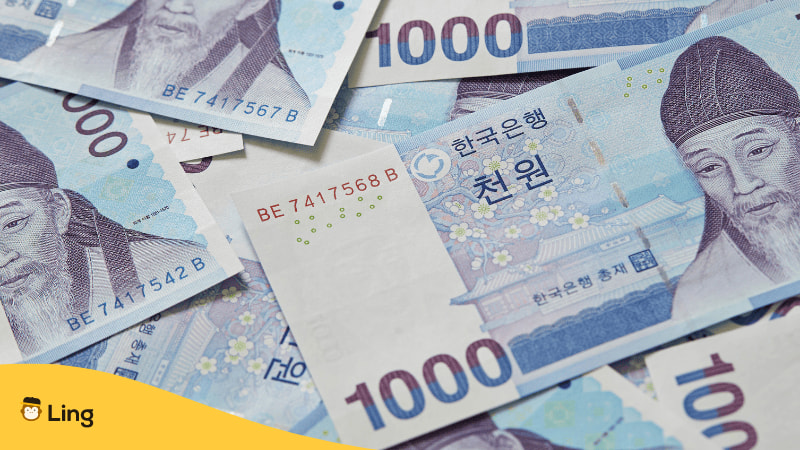
1. ₩1,000 (Won) – (천 원 Cheon Won)
Dollar Exchange Rate: Less than 1 US Dollar (Around $0.89)
Front: 퇴계이황 Toegye Yi Hwang (1501 – 1570)
The ₩1,000 bill is blue in color. The famous personality that you’ll see in front of this bill is Yi Hwang, who is known as a famous Confucian scholar way back from the Joseon Dynasty. Yi Hwang is known for his talent in calligraphy and poetry. Fun fact, the name Toegye is his pen name.
Today, South Koreans cannot talk about Yi Hwang without mentioning the Dosanseowon Confucian Academy(안동 도산서원 Andong dosanseowon), this academy was established six years after his death to give honor him and is now lined up to be one of the UNESCO’S World Heritage Site.
Back: 계상정거도 Gyesangjeonggeodo
If you flip the ₩1,000 bill, you’ll see the painting of Yi Hwang, which is located in Dosan Seowon. We talked about this earlier.
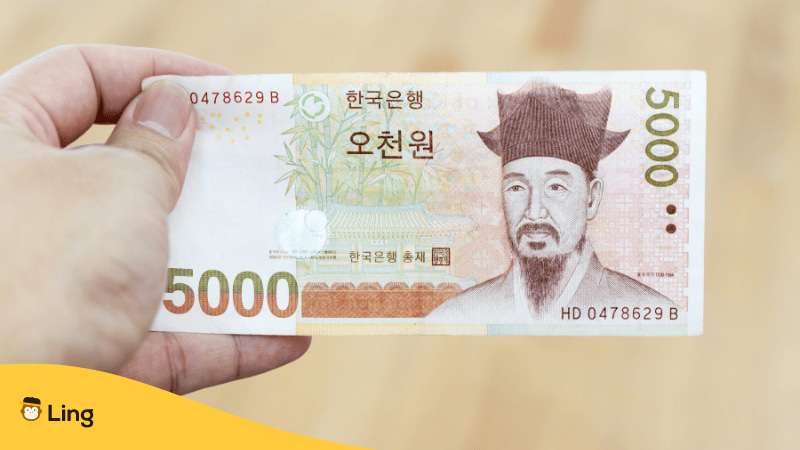
2. ₩5,000 (Won) – (오천원 Ocheon-won)
Dollar Exchange Rate: Around $4.47
Front: 율곡이이 Yulgok Yi I (1536 – 1584)
Moving on to the orange-colored ₩5,000, you’ll see the 율곡이이 Yulgok Yi I, which is a Neo-Confucian thinker who has established the Kiho school in Korea. Fun fact, Yulgok Yi I is Yi Hwang’s (in ₩1,000) student. Yulgok Yi I is Shin Saimdang’s son. But he lost his mother and mourned for three years. After that, he went to the Buddhist temple to be a monk, but he changed his mind after a year.
But that did not stop him from becoming a great person because, with the knowledge he acquired from studying the scriptures, he got first place in preliminary and final civil service exams. Today, he is the Lord First Candidate of the Nine Examinations.
Back: 초충도 Chochungdo
On the back of the 5,000 won note, there is Shin Saimdang’s painting called “Insects and Plants.”
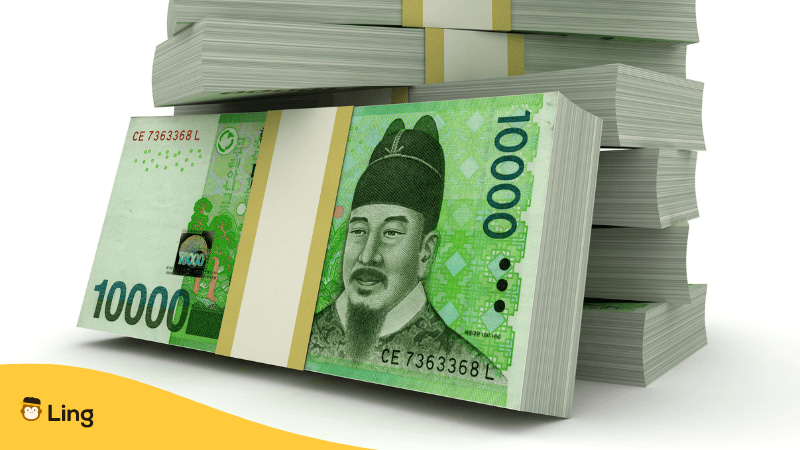
3. ₩10,000 (Won) – (만원 Man-won)
Dollar Exchange Rate: Around $8.93
Front: 세종대왕 Sejong the Great (1397 – 1450)
The ₩10,000 is color green in color. The man featured in this Korean bill is Sejong the Great, the 4th king of the Joseon Dynasty. He is known for introducing Hangeul, the Korean writing system in Korean society. Sejong the Great is known for many other achievements, but introducing Hangeul is definitely one of the most important.
Back: 혼천시계 Honcheonsigye
The back of this bill is a picture of the Hocheon Clock” or the 혼천시계 (honcheonsigye). It is an astronomical clock made in 1669.
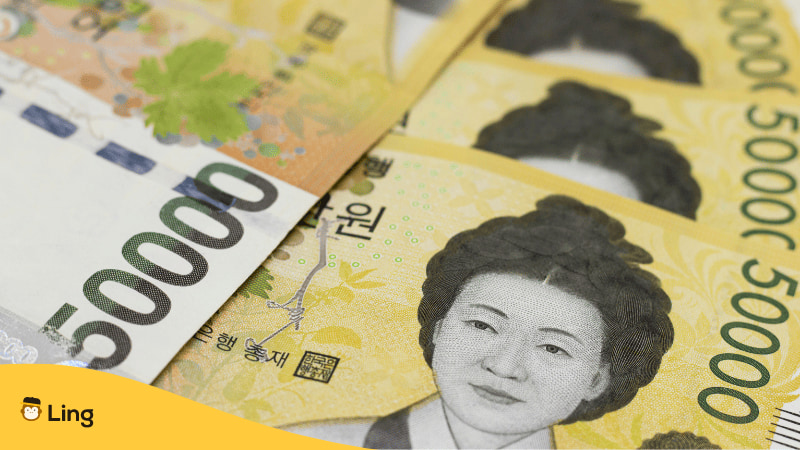
4. ₩50,000 (Won) – (오만원 Oman-won)
Dollar Exchange Rate: Around $44.69
Front: 신사임당 Shin Saimdang (1504 – 1551)
Does this name sound familiar to you? Yes, she is Yi I’s mother, the person in the ₩5,000 bill. Shin Saimdang is a poet and a calligraphist whose artworks capture mostly beautiful and delicate images of flowers, fish, insects, and landscapes. She is a well-known historical figure, and she was considered an icon of the “wise mother and good wife” (hyeonmoyangcheo,현모양처).
The ₩50,000 is in the color yellow, and it’s the most significant denomination of the Korean bill.
Back: 월매도 Wolmaedo
The back of ₩50,000 is a 월매도 Wolmaedo or simply plum tree.
Korean Currency: Korean Coins (한국 동전 Hanguk Dongjeon)
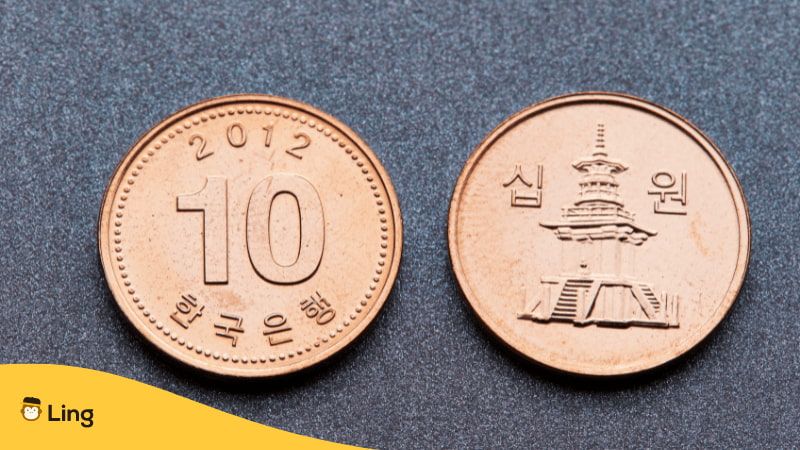
10 won – (십원 Sip-won)
Front: 다보탑 (Dabotap Pagoda)
Back: Value (digit), bank title, year of minting
Significance: The 10-won coin pays tribute to the famous temple in Gyeongju.
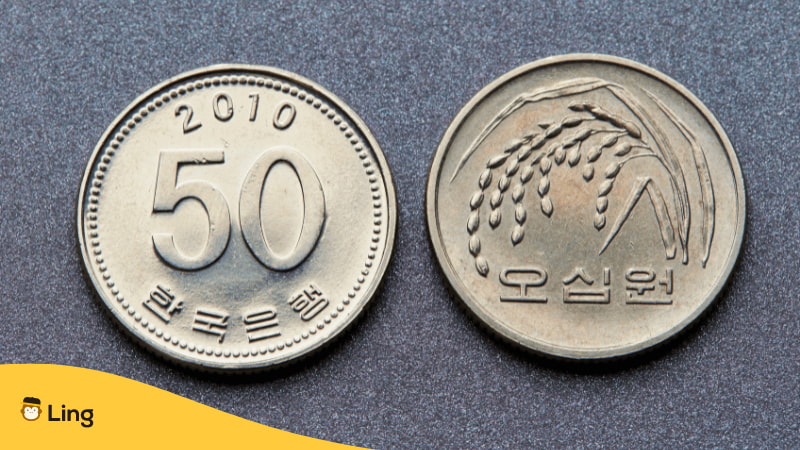
50 won (오십원 Osip-won)
Front: Stalk of rice
Back: Value (digit), bank title, year of minting
Significance: This simply means that the rice is tasty.
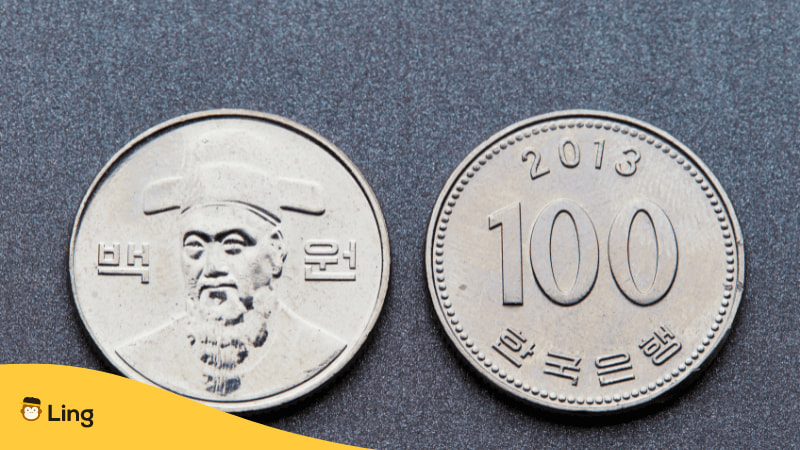
100 won (백원 Baek-won)
Front: 이순신 (Yi Sun-sin)
Back: Value (digit), bank title, year of minting
Significance: Yi Sun-sin is Korea’s favorite admiral
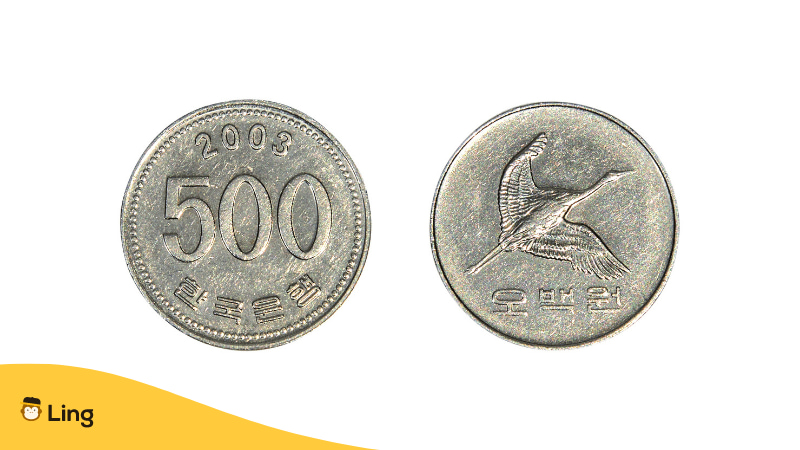
500 won (오백원 Obaek-won)
Front: 두루미 (Red-crowned crane)
Back: Value (digit), bank title, year of minting
Significance: The red-crowned crane is a beautiful crane that you can find in Korea
Where Can I Exchange My Money In South Korea?
It is impossible to go to South Korea without shopping for different K-pop merch, Korean food, mobile phones, designer pieces, skincare products, makeup, and more. If you’re a foreigner and you are holding a different currency, such as the US dollar, you’ll have to exchange your US dollar for South Korean won. So, it is important to know places in Korea with the best exchange rates.
Take note of the list below so that when you go to Korea, you know where to go:
Money Changers in Myeongdong
Best Rates For USD, HKD, CNY/RMB, AUD, GBP, EUR, SGD, TWD, JPY
- Money changer at 26 Myeongdong 2-gil
- Shinhan Bank
- Money changer at Chungmuro
- Woori Bank
- Money changer at Namdaemun-ro
Money Changers in Itaewon
Best Rates For USD, AUD, GBP, EUR, JPY
- KEB Hana Bank at Itaewon
- Woori Bank at Itaewon
- Industrial Bank of Korea at Itaewon
- Shinhan Bank at Itaewon
- Kookmin Bank @ Itaewon
Money Changers in Dongdaemun
Best Rates For USD, CNY/RBM, CAD, AUD, JPY
- KEB Hana Bank at Dongdaemun
- Woori Bank at Dongdaemun
- Kookmin Bank at Dongdaemun
- Shinhan Bank at Dongdaemun
Keb Hana Bank (Formerly known as Korean Exchange Bank)
Best Rates For: EUR, GBP, USD, JPY, AUD, SGD, MYR, CNY, CAD
- KEB Hana Bank at Sogong-dong
- KEB Hana Bank at Itaewon
- KEB Hana Bank at Gangnam-gu
- KEB Hana Bank at Toegye-ro
Korean Currency: Korean Words Related To Money
| English Translation | Hangeul (Korean) | Romanization |
| allowance, spending money | 용돈 | yongdon |
| money | 돈 | don |
| to pay (money) | 내다 | naeda |
| pay money | 돈을 지불하다 | doneul jibulhada |
| lots of money | 많은 돈 | maneun don |
| money exchange | 환전 | hwanjeon |
| Save money. | 소비절약하기 | sobijeoryakhagi |
| I need to save some money. | 나는 돈을 좀 저축해야 해 | naneun doneul jom jeochukhaeya hae. |
| I do not have cash. | 나는 현금이 없다 | naneun hyeongeumi eoptta. |
| Can I borrow some money? | 돈을 좀 빌릴 수 있을까요? | doneul jom billil su isseulkkayo? |
| Do you have any money? | 돈이 있습니까? | doni isseumnikka? |
| I am broke. | 나는 빈털털이야. | naneun binteolteoriya. |
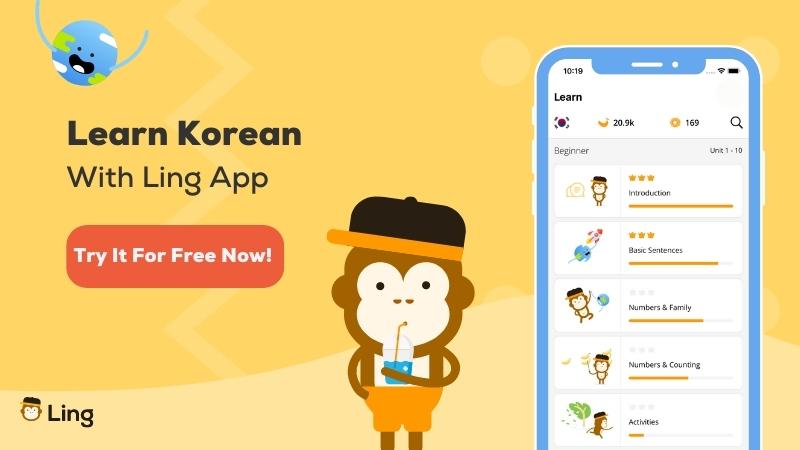
Learning Korean Is A Worthy Investment
Nowadays, earning money is getting tougher. That is why people are looking for opportunities both local and international. But, little did they know that knowing a foreign language is one edge to successfully landing a job abroad. If you’re into Korean culture and you want to work in South Korea, learning Korean is a worthy investment. To do that, you’ll need tools and resources that will help you learn Korean effectively and conveniently, like the Ling app.
Ling app is a language learning platform that aims to help language learners achieve success in language learning. Using well-structured lessons backed with linguistic research, a variety of topics and activities, dialogues, mini-games, and quizzes, this amazing platform provides learners with an innovative and meaningful language learning experience.
Learning a new language is a kind of treasure that nobody can ever take away from you. If you know how to speak Korean, you can start doing different Korean-related things like blogging, vlogging, tutoring, and more. So, don’t waste any time and learn Korean when you download the Ling app on the Play Store or App Store now!
Updated by: Gwyn
















